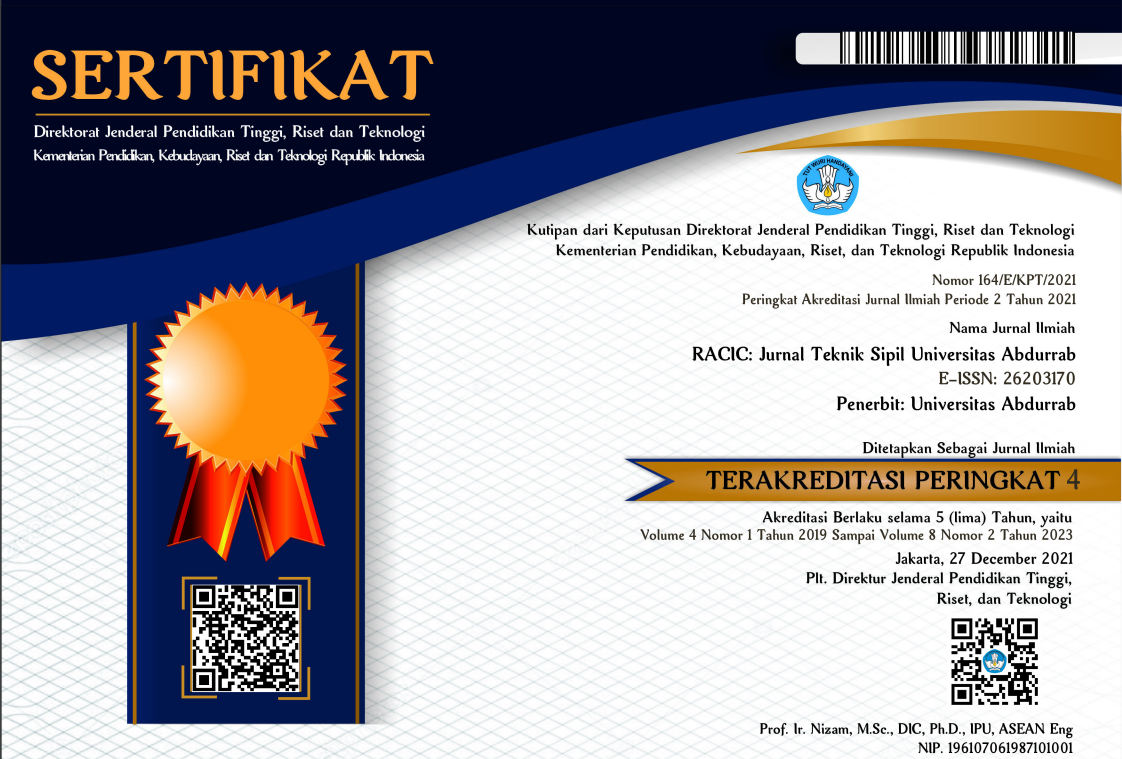POTENSI PENGGUNAAN CAMPURAN SLAG NIKEL DAN FLY ASH SEBAGAI MATERIAL PERKERASAN JALAN
Abstract
The reuse of recycled materials on a large scale for geotechnical projects, such as in road pavements, will make it more economical and support environmental sustainability. Nickel slag and fly ash are examples of by-products of ferronickel and coal processing. In this study, a mixture of nickel slag and fly ash was investigated to be an alternative material for road pavement structures. The use of Class F fly ash is used as a filler and stabilization material. Laboratory testing is planned for the composition of the mixture of 5%, 8%, 11%, 14%, 17%, and 20% FA in the design criteria for compaction test (modified proctor), California Bearing Ratio (CBR), swelling potential and permeability . The results showed an increase in CBR values for all mixtures. The composition of 11% FA has a minimum of 90% CBR value in soaked conditions. The potential for swelling still meets the maximum value limit of 0.5% (low degree of expansion). Permeability coefficients are only in the range of greater than 10-5 m/sec (medium permeability) where mixed combinations are categorized for roads with traffic volumes less than 500 vehicles/day.
References
[2] Budhisantoso dan Prasetya. (2004). Pengaruh Serat Polyethylene Terhadap Kuat Tekan dan Kuat Tarik Beton Non Pasir dengan Agregat Kerikil Asal Gunung Merapi’.
[3] Das, B.M., Emeritus, D. and Sobhan, K. (2012). Principles of Geotechnical Engineering.
[4] Hartono, S.J. (2012). Nilai CBR Soaked dan Kv Subbase Course pada Batu Kuning (Dolomite Limestone) dengan Rasio Perbandingan Agregat Kasar dan Agregat Halus’.
[5] Indonesia Ministry of Energy and Mineral Resources (2020). Peluang Investasi Nikel Indonesia. Kementerian Energi dan Sumber Daya Mineral Republik Indonesia, pp. 1–40.
[6] Mohammad, S. and Tasalloti, A. (2016). Behaviour of blended waste materials for land reclamation for port extension School of Civil. Mining and Environmental Engineering Behaviour of Blended Waste Materials for Land Reclamation for Port Extension.
[7] Rai, A.K., Paul, B. and Singh, G. (2010). A Study on Backfill Properties and Use of Fly Ash for Highway Embankments. Journal of Advanced Laboratory Research in Biology. pp. 110–114.
[8] Siswosoebrotho, B.I., Augusta, E. and Pamudji., W. (2005). The Influence of Fines Content and Plasticity on the Strength and Permeability of Aggregate for Base Course Material. The Eastren Asia Society for Transportation Studies. pp. 845–856.
[9] Wenno, Rudolvo et al. (2014). Kuat Tekan Mortar Dengan Menggunakan Abu Terbang (Fly Ash) Asal PLTU Amurang sebagai Substitusi Parsial Semen. pp. 252–259.
[10] Yamin, A. (2013). Pemanfaatan dan Kinerja Agregat Substandar sebagai Bahan Konstruksi Jalan.
[11] Bina Marga. (2010). Spesifikasi umum 2010. Direktorat Jendral Bina Marga (Revisi 3), pp. 1–6.
[12] SNI 03-1744. (1989). Metode Pengujian CBR Laboratorium.
[13] SNI 8379. (2017). Spesifikasi Material Pilihan Menggunakan Slag untuk Konstruksi
Jalan.
[14] SNI 2435. (2008). Cara Uji Kelulusan Air Benda Uji Tanah di Laboratorium dengan Tekanan Tetap.
[15] SNI 2417. (2008). Cara Uji Keausan Agregat dengan Mesin Abrasi Los Angeles.
[16] SNI 1743. (2008). Cara Uji Kepadatan Berat untuk Tanah.
[17] SNI 03-4141. (1996). Metode Pengujian Gumpalan Lempung dan Butir Mudah Pecah.
[18] SNI 7619. (2012). Metode Uji Penentuan Persentase Butir Pecah pada Agregat Kasar.
[19] SNI 1966. (2008). Cara Uji Penentuan Batas Plastis dan Indeks Plastisitas Tanah.
[20] SNI 03-1968. (1990). Metode Pengujian tentang Analisa Saringan Agregat Halus dan Kasar.
[21] SNI 03-1969. (1990). Metode Pengujian Berat Jenis dan Penyerapan Air Agregat Kasar.
[22] QA Spesification 3051. (2020). Granular Pavement Base and Subbase Materials.
[23] Kementerian LHK. (2020). Pemanfataan Limbah Berbahaya dan Beracun.
Copyright (c) 2022 RACIC : Rab Construction Research

This work is licensed under a Creative Commons Attribution-NonCommercial-ShareAlike 4.0 International License.
1. Copyright of all journal manuscripts is held by the RACIC : Rab Construction Research
2. Formal legal provisions to access digital articles of electronic journal are subject to the provision of the Creative Commons Attribution-ShareAlike license (CC BY-NC-SA), which means that RACIC : Rab Construction Research is rightful to keep, transfer media/format, manage in the form of databases, maintain, and publish articles.
3. Published manuscripts both printed and electronic are open access for educational, research, and library purposes. Additionally, the editorial board is not responsible for any violations of copyright law.
licensed under a Creative Commons Attribution-ShareAlike 4.0 International License.
 PDF (Bahasa Indonesia)
PDF (Bahasa Indonesia)
 Abstract views: 365
Abstract views: 365
 downloads: 314
downloads: 314

 :
:







